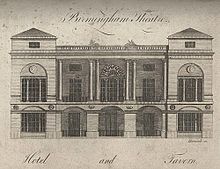Samuel Wyatt
Samuel Wyatt(8 September 1737 – 8 February 1807) was anEnglisharchitectandengineer.A member of theWyatt family,which included several notable 18th- and 19th-century English architects, his work was primarily in aneoclassicalstyle.
Career
[edit]
In his twenties, Wyatt was master carpenter and laterRobert Adam's clerk of works atKedleston HallinDerbyshire,which was a landmark in Englishneoclassical architecture.He later worked with his brotherJames Wyatton thePantheonin Oxford Street, London. He designed neoclassical country houses such asTatton Parkin Cheshire, andTrinity Housein London andDigswell Housein Hertfordshire.
Wyatt's career was diverse. He designed theAlbion Millsin London, which was the first in the world to be powered by steam engines, and patented designs for cast iron bridges. He designed model farm buildings, cottages, and several lighthouses, including those atDungeness,LongshipsandFlamborough Head.
Between 1784 and 1807 Samuel worked as architect to theHolkham Hallestate,[1]he designed several farms, 'The Great Barn' as well as the newkitchen gardenwith its hothouses, including 'The Vinery'. He used a simplified new-classical style for these buildings.
In 1791 Samuel was hired by Rev Edward Hughes to design and build an early version ofKinmel Hallin Abergele, Wales, which he completed in 1802 and which is referred to as the Wyatt Kinmel.
Samuel Wyatt developed a friendship withMatthew Boulton,for whom he designedSoho Housein theHandsworthStaffordshire (nowBirmingham) in 1789. Prior to this, Boulton recommended him to the proprietors of theTheatre RoyalonNew Street, Birminghamin 1777, and in 1780, aporticoof coupledIonic columnsbetween arched wings was added to the front of the theatre to a design by Wyatt. It is also believed that he was recommended by Boulton toJames Watt,for whom Wyatt designedHeathfield Housein Handsworth. This was completed in 1790. He was also responsible for work atMoseley Hallin theMoseleyarea of Birmingham.
Together withCharles Tathamhe also designedDropmore HouseinBuckinghamshire,which was built in the 1790s for theprime ministerat the time,Lord Grenville,who pushed through the law abolishing the slave trade.[2]At the turn of the 19th century, he remodelled and extendedShugborough HallforViscount Anson.
Gallery of architectural work
[edit]-
Tatton Hall, Cheshire
-
Trinity House, London (Samuel's work is in stone on the left)
-
Soho House,Staffordshire
-
Heathfield Hall- 1835 painting byAllen Edward Everitt
-
Shugborough Hall,Staffordshire
-
Doddington Hall, Cheshire
-
The Great Barn, Holkham estate Norfolk
-
Belmont House,Throwley, Kent, built 1789–1793 for Colonel John Montresor
-
Kinmel Hall,Abergele
-
Flamborough Head Lighthouse, Yorkshire
See also
[edit]References
[edit]- ^Martins, Susanna Wade. "A Great Estate At Work: The Holkham Estate and its Inhabitants in the Nineteenth Century". Cambridge University Press, 1980. 155.ISBN0-521-22696-1
- ^Timpson, Trevor (1 April 2007)."Abolitionist's house escapes ruin - BBC news 1 April 2007".BBC News.Retrieved6 February2009.
- Douglas Hickman (1970).Birmingham.Studio Vista Ltd. p. 5.
External links
[edit]- John Martin Robinson's doctoral thesis, "Samuel Wyatt, architect"via Oxford Research Archive










